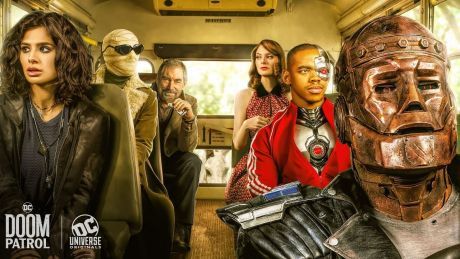Arts
You are here
Doom Patrol – the superhero antidote to Trump’s America

June 15, 2019
I tuned in to Doom Patrol (Space Channel) with low expectations. Another superhero show, yawn. And this one from the DC universe, so full of angst-ridden billionaire vigilantes, uber-men and world saving princesses.
So imagine my surprise when Narrator/Super Villain Mr. Nobody (Alan Tudyk) agrees. As he gleefully teases the audience: “More TV superheroes, just what the world needs. Have you hung yourself yet?” Mr. Nobody is the product of post-war Nazi experiments, fiendishly adept at manipulating the minds of his opponents, using their fears and insecurities against them as individuals and as a group. He is also the only character to regularly break the “fourth wall” and directly address the audience with comments on the proceedings. Is he manipulating us?
And what a group our “heroes” are: Jane/Crazy Jane (Dianne Guerrero), a woman with 64 personalities, each with their own power and/or liability; Cliff Steele/Robot Man (Brendan Fraser), a misogynistic NASCAR champion whose brain is all that survives a crash, only to be implanted into a clunky, retro robot body; Rita Farr (April Bowlby), a narcissistic 1950s film star who ingests a mysterious fungus while on a South American location shoot, and turns to an elastic ooze whether she likes it or not; Vic/Cyborg (Joivan Wade), a troubled teenager whose father (who has shady dealings with the military-industrial complex) has turned him into a part machine following an accident; and Larry Trainor/Negative Man (Matt Bomer), a closeted “right stuff” sort of test pilot whose body becomes inhabited by a mute being made up of electrical charge, but whose actual body is horribly disfigured by fire and nuclear radiation after a plane crash, and who appears – except in flashbacks, of which there are plenty – wrapped head to toe in bandages reminiscent of the Invisible Man.
All of them find themselves in the mansion of Niles Calder/The Chief (Timothy Dalton), physician, psychologist, inventor and implacable opponent of Mr. Nobody. Is The Chief a part of the shadowy government intelligence agency, the Bureau of Normalcy, or is he trying to create a sort of super team to bring it down? Before we can figure it out he is kidnapped. Out of personal loyalty and affection, each of our protagonists agree to band together, sort of, and rescue him.
If all this seems weird, it is. The writing is an amalgam of scatological humour, pathos and absurdist satire. The characters exist out of time, with a visual style that evokes multiple decades. Robot Man is right out of a cheesy drive-in movie, while Cyborg is state of the art. Crucial supporting characters include Flex Mentalo, the jut-jaw muscle man from the ads in the comic books; a farting donkey that is actually a portal to another dimension; and Danny the Street, a gay-positive road that hosts gender fluid, cross-dressing entertainment, but constantly has to move its location to evade the Bureau of Normalcy.
Is this the America of Donald trump’s MAGA fantasy? One thing that is clear, Doom Patrol is anti-fascist to the core, presents its LGBTQ subplot in a wonderfully subversive way, and avoids the sexist tropes that weaken so much of the genre. I suspect that the usual fanboys who complain about too many women heroes or POC in their favourite sci-fi franchises really dislike Doom Patrol.
It is hard to go further without spoiling the inventive, funny and genuinely touching plot that unfolds as this group of “loveable losers” (Mr. Nobody’s words) unites. The heroes are all disabled in one way or another (even The Chief is in a wheel chair) – physically, mentally or spiritually scarred. But rather than fall into the cliché of “overcoming” their handicaps the Doom Patrol learns to accept and fight on. Maybe we aren’t doomed after all.
Section:
Topics:










